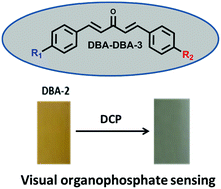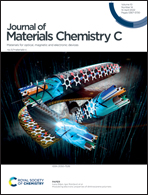Visual organophosphate vapor sensing by dibenzylidine derivatives exhibiting intramolecular charge transfer and aggregation induced emission†
Abstract
Organophosphate vapor sensing by the naked eye is highly sought albeit challenging to accomplish in practice. We demonstrate that a donor/acceptor dibenzylidine derivative, displaying both internal charge transfer (ICT) and aggregation-induced emission (AIE) facilitate rapid and specific visual detection of organophosphate gas molecules. Notably, by tuning the electron donating/withdrawing capacities of the pendant residues of dibenzylidine we observe unusual transition between positive and negative solvatochromism and distinct AIE behavior. In particular, halogen release facilitated chemical reaction between specific organophosphate molecules and the electron donor units displayed on the dibenzylidine framework, disrupting charge transfer and giving rise to visible color change. Structural and computational analyses shed light on the luminescence features and optical tunability of the compounds, particularly their sensitivity both to solvent environments and reactions with vapor molecules.



 Please wait while we load your content...
Please wait while we load your content...